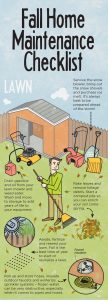The end of summer provides an opportunity to revive your lush green lawn with nitrogen and air that facilitates root health and healthy soil compaction. During this time of year, grass is absorbing energy, moisture, and nutrients in preparation for the winter.
Give your lawn a little attention now, and you’ll have a lush, healthy spring lawn We’ve compiled 6 easy steps you can follow to help you keep the “grass greener” on your side.
KEEP ON MOWING
Continue to water and mow your lawn, as needed, throughout the fall. Then as the season draws to a close, drop the mower’s blade to its lowest setting for the last two cuttings of the year. That will allow more sunlight to reach the crown of the grass, and there will be less leaf to turn brown during the winter.
AERATE THE SOIL
Fall is also an ideal time to aerate your lawn so that oxygen, water, and fertilizer can easily reach the grass’s roots. You can rent a gas-powered, walk-behind lawn aerator for about $70 per day. The self-propelled machine will quickly punch holes into the soil and extract plugs of dirt.

Take these simple steps with your grass now and you’ll have a head start on a healthy lawn for next spring.
RAKE THE LEAVES
I know raking leaves is no one’s idea of fun, but it’s important to remove fallen leaves from your lawn as soon as possible. Don’t wait until all the leaves have fallen from the trees to start raking. If you do, the leaves will become wet from rain and morning dew, stick together, and f left unmoved will suffocate the grass and breed fungal diseases
FERTILIZE FOR FUTURE GROWTH
Most lawn experts agree: If you fertilize your lawn only once a year, do it in the fall. The reason? Grass leaves grow much more slowly as the weather turns cool, but the grass roots and rhizomes continue to grow quickly. A fall application of fertilizer delivers essential nutrients for the grass to grow deep roots now and to keep nutrients on reserve for a healthy start next spring.
*Rhizomes are the horizontal plant stems that lie just beneath the soil’s surface; they produce the blades of grass above and the roots below.)
FILL IN BALD SPOTS
Autumn is also a great time of year to fix any bare, bald spots in your lawn. Use a garden rake to scratch loose the soil at the bald spot in your lawn. Then spread a thick layer of a lawn repair mixture over the area. Lightly compact the mixture, then water thoroughly, and continue to water every other day for two weeks.
RESEED YOUR LAWN
Is your lawn looking thin and brown? Well, reseeding can help you get back to the thick, lush, green lawn you’ve always wanted. If you put down a layer of seed over your lawn in the spring or fall, all the thin areas start growing grass, and your lawn starts to look terrific again.
With autumn nearly upon us and winter rapidly approaching, you’re probably not spending much time thinking about your lawn. But autumn, with its cooler temperatures and occasional rainfall, it’s the ideal time to get a head start on a healthy lawn for next spring!
#greenyourhomeup



















Leave A Comment